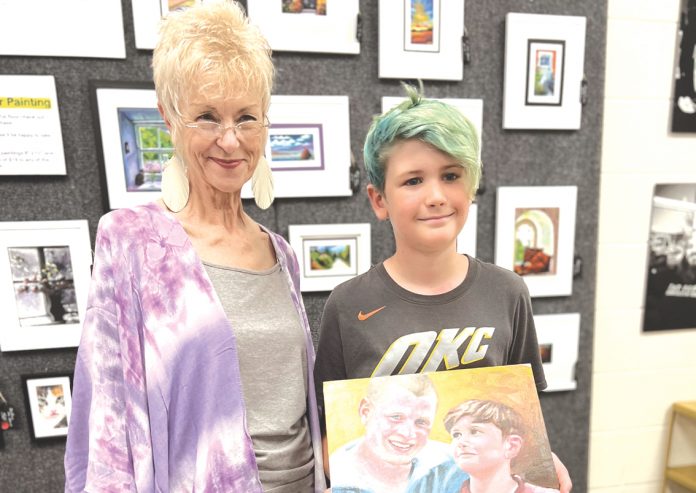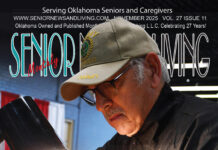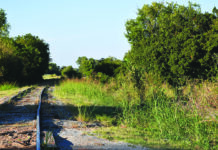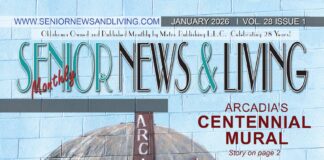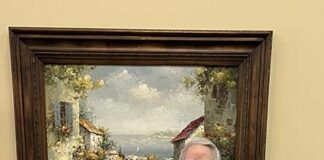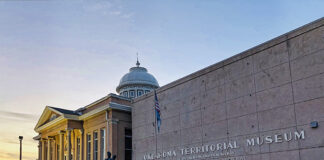Story and photo by Darl DeVault, Contributing Editor
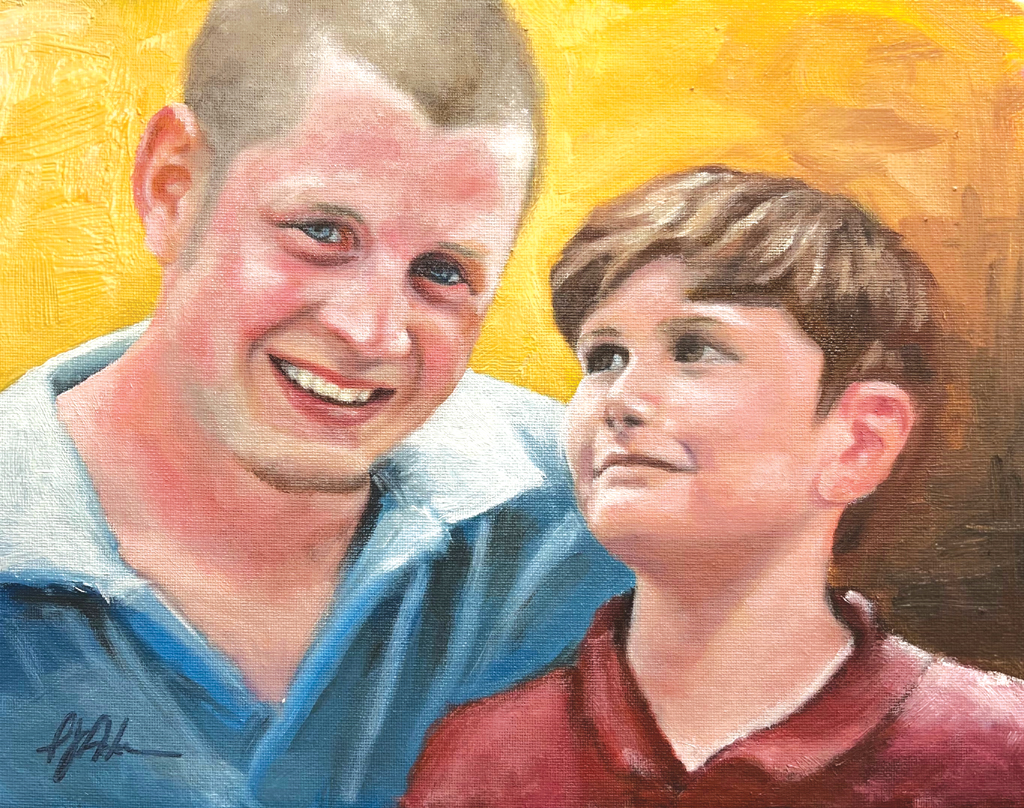
Faced with a challenge many artists would not be able to pull off, PJ Acker recently used her easily demonstrable talent and social grace to create an oil painting a young boy will cherish forever. In capturing the boy’s likeness while adding the photorealistic painting of his deceased father, she provided the family with a comparative study for the ages.
Working in her newly named Treehouse Studio, located upstairs of the Paseo Arts and Creativity Center (PACC) building, Acker was recently touched by a special commission.
Her narrative of what happened next is so direct it is largely unedited: “He doesn’t have a photo of his Daddy and him together,” A young woman named Leah whispered to me. She and her son, Brayden, were visiting my studio during a recent First Friday Art Gallery Walk. Brayden, 11 or 12 years old, seemed captivated by the process of the pencil sketch I was doing of another visitor. When I asked if he’d like his portrait sketched, he was shy but seemed very eager, nodding yes.
While Brayden was occupied with looking over the sketch I’d completed for him, Leah whispered to me, “If I supply a photo of his dad, could you paint a portrait of them together?”
I’ve done similar portraits for others, so I told her I’d love to try. Soon, our plan was made. As we visited, I discreetly snapped several photos of Brayden with my phone.
Over the following weeks, I chose from photos Leah emailed and developed a composition. After emailing a rough draft for her approval, I got to work. While it usually takes about two months to finish a portrait from start to finish, this project touched my heart and had my full attention. I completed the painting in three weeks. These kinds of projects make the years of study and practice pay off.
I form a connection with my portrait subjects while studying their faces and the tiny nuances of expression. I become energized, excited and eager to commit to canvas what I see and feel.
In one of our communications, Leah confessed to me she’d cried more than a few tears while watching the painting as it developed. While it’s common for me to feel connected to my subject during the hours of trying to capture its essence onto canvas, a process called ‘chasing the likeness,’ this one felt special to me.
Arriving to pick up his painting, Brayden entered my studio closely following his mother. His eyes immediately landed on the 11 by 14-inch portrait in oil on the center table.
He stared motionlessly at it from the doorway. When he didn’t move or speak for minutes that seemed an eternity, I silently sought out his mother’s eyes. She gently moved him toward the table. I lifted the painting into his hands. Remaining silent, his eyes never left the painting.
“He’s overwhelmed,” his mother told me, smiling.
We took a couple of photos together, Brayden, his painting and myself, before they left.
Ten minutes later, I received a text from Leah, “He hasn’t let go of the painting. He’s crying quietly in the backseat.”
Being a mother and grandmother herself, Acker understood a mother’s desire to give her son a link to his father.
Capturing common similarities of expression while portraying an ease of comfort between the two required a certain intuitiveness. Employing the power of photorealism while imagining “what would be” required imagination. Blending disparate images with different settings and lighting conditions required technical ability. Doing these things simultaneously defines the challenge and artform of this type of portraiture.
Sketching her first portraits in pencil and crayon, Acker recalls from her childhood, “I’ve always been fascinated with faces, with watching and studying people.”
Holding true to this, she chose nursing as her first vocation. Seven years later, she taught herself the skills needed to work as a technical typist at the School of Aerospace and Mechanical Engineering at the University of Oklahoma. With a promotion to a position with the Oklahoma Department of Human Services Training Department, she worked with and scheduled mandatory workshops for social workers throughout Oklahoma.
After retiring, her passion for creating art reignited. Doggedly pursuing whichever technique or medium that called to her at the time, Acker acquired her education in art attending workshops across the country, as well as seminars and art courses locally at Rose State College and OCCC. Workshops with Philippe Faraut, a world-renowned sculptor, and Betty Pat Gatliff, past Forensic Reconstructive Sculptor for the State of Oklahoma, encouraged her love of portraiture and figurative art. She has created works in oil, acrylic, oil pastel, soft pastel, charcoal, watercolor, soft clay, and oil-based clay for bronze work.
For the last 25 years, Acker has worked as a professional artist in Oklahoma and has been a member of the Oklahoma Art Guild, Oklahoma Sculpture Society, Oklahoma Pastel Society and the Portrait Society of America. She cites John Singer Sargent, John Howard Sanden, Berthe Morisot and Philippe Faraut as her primary influences.
Her artistic passion continues to grow and develop as it chooses from her Treehouse studio. She blogs about works-in-progress and accepts commissions through her website www.pjackerart.com.
Visitors are welcome during her usual studio hours: Tue – Sat 10:30 a.m. – 4 p.m. and 6 – 9 p.m. every month on Paseo’s First Friday Gallery Walk.
“What I paint or sculpt now is often more informed by what I feel than by what I see,” Acker said in an interview. “Capturing the essence of a person on canvas or clay has always been magical to me. Creating is the anchor that reminds me of who I am, from whom I come, and I’m happy to be able to share.”
The Paseo Arts Association hosts the PACC as a 501(c)(3) non-profit organization working since 1981 to develop the historic Paseo into a thriving arts district.
Oklahoma City’s only authentic arts district is known for its eclectic galleries attached to art studios, high-quality restaurants, bars, and many types of merchants. The walkable cultural area surrounding a curving street features Spanish Revival architecture with trees providing shade during its well-attended Arts Festival each May. The three-day event Memorial Day Weekend – May 28-30 this year usually adds 100 artist’s booths to what the 80 district resident artists offer.


